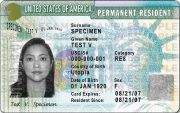Related Links
Immigrants by Country of Origin Immigration Facts Immigration Milestones Immigration Legislation More About Immigration
Not Always Green
In May 2010, the U.S. Citizenship and Immigration Services (USCIS) announced that new cards, as well as cards up for renewal or replacement, will, in fact, be green. The Green Card, you see, has not always been green. In 1940, the Alien Registration Act (Smith Act) for the first time required all non-citizens age 14 and over to register and be fingerprinted. In return, these immigrants were sent an Alien Registration Receipt Card. Ten years later, these cards were replaced with the Form I-151 cards, which were green, and the nickname was born. Since 1950, the cards have come in many colors, including beige, pink, blue, and white. The Form I-551 Green Card of today shares little in common with its avocado-colored predecessor beyond tint; the new cards showcase cool technological features, including secure optical media that will store biometrics for rapid and reliable identification of the card holder, and holographic images, laser engraved fingerprints, and high resolution micro-images that will make the card nearly impossible to reproduce. No matter the color, these cards have been—and continue to be—highly desirable.
Winning the American Dream
The most dramatic way to (legally) get one’s hands on a Green Card is through the Diversity Immigrant Visa Program—also known as the Green Card Lottery. Since 1999, 55,000 visas are reserved for the annual lottery, with 5,000 withheld for use under the Nicaraguan and Central American Relief Act (NACARA). It costs nothing to apply, and winners are selected randomly from eligible entries. The idea behind the program is to encourage participation from countries with low rates of immigration to the United States. The visas are distributed among six geographic regions, with a greater number of visas allocated to regions with lower rates of immigration, and with no visas going to natives of countries who sent more than 50,000 immigrants to the United States over the past five years. Finally, no single country may receive more than 7% of the available Diversity Visas in any one year. In addition to the country criteria, an eligible applicant must provide proof of a high school education or its equivalent, or show two years of work experience in an occupation that requires at least two years of training or experience within the past five years. A computer-generated, random drawing chooses the winners. For the year DV-2014, there were 9,374,191 qualified entries (14,633,767 including spouses and children) in the Green Card Lottery. Of these, 140,660 applicants were registered and notified as being eligible to apply for an immigrant visa. While these odds are better than “one in a million,” they are not great; but for those who win, it is a priceless shot at the American Dream.
Not a Free Ride
In 2012, 1,021,631 applicants were granted legal permanent resident status. The 50,000 Green Card Lottery winners represent only 5% of this total. But no matter the source, these new permanent residents on their path to citizenship, have both rights and responsibilities. The Department of Homeland Security makes these clear:
Rights
As a permanent resident (Green Card holder), you have the right to:
live permanently in the United States provided you do not commit any actions that would make you removable under immigration law. work in the United States at any legal work of your qualification and choosing. (Some jobs are limited to U.S. citizens for security reasons.) be protected by all laws of the United States, your state of residence, and local jurisdictions.
Responsibilities
As a permanent resident, you are:
required to obey all laws of the United States the states, and localities. required to file your income tax returns and report your income to the U.S. Internal Revenue Service and state taxing authorities. expected to support the democratic form of government and not to change the government through illegal means. required, if you are a male age 18 through 25, to register with the Selective Service.
More from Immigration
